Cauliflower is a Brassica family member, including broccoli, Brussels sprouts, cabbage, and kale. When growing Cauliflower, there are several things to consider, such as soil type, propagation, planting, care, and farming tips.
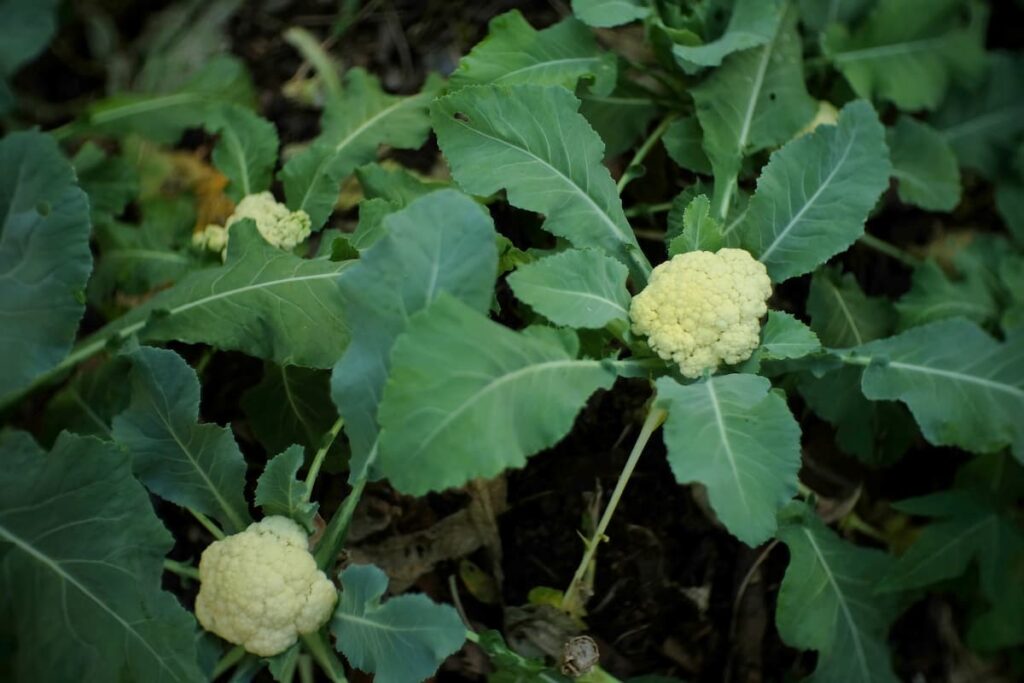
How to grow Cauliflower in the USA
Soil requirement for growing Cauliflower in the USA
- Cauliflower (Brassica oleracea) is a cool-weather crop, and it can be grown in most parts of the USA in the spring or fall. Cauliflower prefers rich, well-drained soil with pH levels of 6.0 to 7.0. The best way to determine if your soil is sufficiently fertile is to have it tested by your local cooperative extension service.
- If your soil is too sandy, you can improve its structure and fertility by adding organic matter such as compost or well-rotted manure. If your soil is too clayey, you can improve its drainage by amending it with sand or other coarse materials.
- Once you have determined that your soil is adequate for growing Cauliflower, you will need to prepare it for planting. This involves tilling the soil to a depth of 10-12 inches and applying a balanced fertilizer according to the soil test results.
Cauliflower growing season in the USA
In the United States, Cauliflower is typically grown in spring and fall. Fall planting will produce heads during the winter, while spring planting will produce heads during the summer.
Cauliflower varieties in the USA
- Headless – This type of Cauliflower has no head and is harvested for its stalks and leaves. Headless Cauliflower is also known as “broccoli raab” or “rape.”
- Self-Blanching – This type of Cauliflower has a small, compact head surrounded by leaves. The leaves help to protect the head from the sun, which keeps it white.
- Colored – Colored Cauliflower comes in several different varieties, including orange, green, and purple. These varieties are typically more nutrient-dense than white Cauliflower.
- Snowball: A white, globe-shaped variety most common in the US. It can be harvested in 60-90 days.
- Bianca Rosa: An Italian heirloom variety with beautiful pale pink flowers. It has a nutty flavor and takes 70-80 days to mature.
- Veronica: A purple Cauliflower with a sweet, nutty flavor. It takes 80-85 days to mature and is often used as an ornamental plant due to its unique color.
In case you missed it: Cauliflower Pests, Diseases, And Control Methods
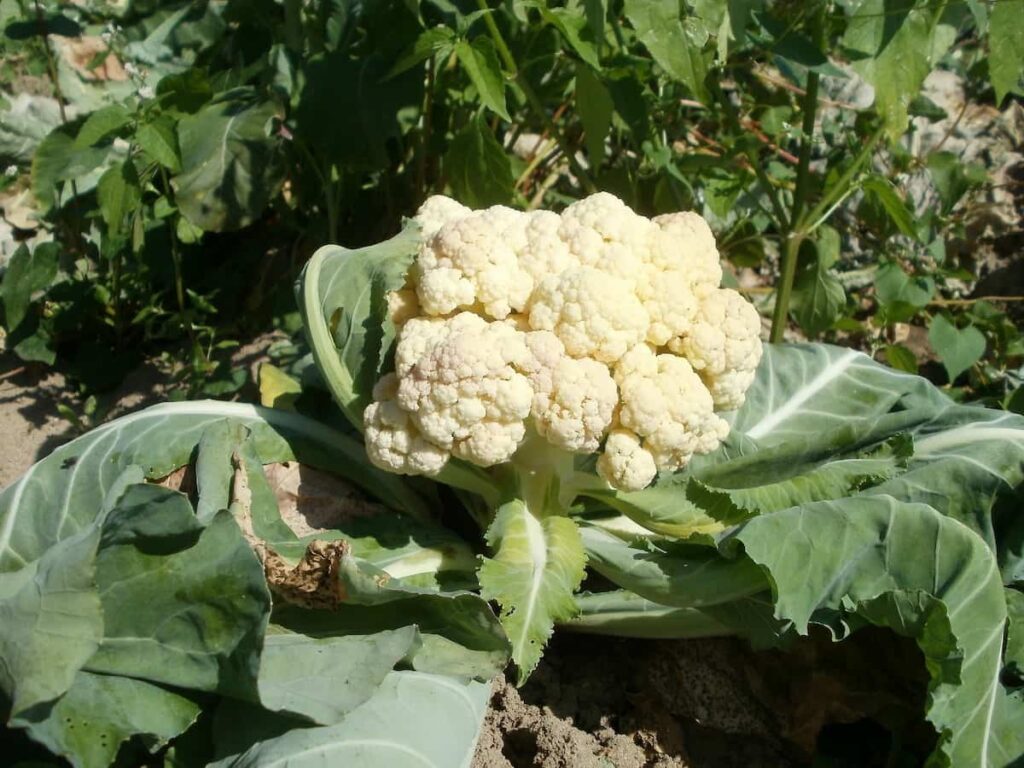
Cauliflower farming tips for profit
- Cauliflower farming can be a profitable endeavor if done properly. To grow Cauliflower in the USA, farmers must have rich, well-drained soil. Cauliflower can be propagated by seed or by transplants.
- When it comes to Cauliflower, there are two main types: early and late. Early varieties take around 60 days to mature, while late varieties can take up to 90 days.
- Cauliflower is a popular vegetable in the United States. The best place to grow Cauliflower is in an area with plenty of sunlight and rich, well-draining soil.
- When planning to grow Cauliflower, choosing a reputable seed company or nursery that offers high-quality seeds or plants is essential. Once you have your seeds or plants, you’ll need to prepare the soil by adding organic matter and getting rid of any weeds.
- To propagate Cauliflower, you can start with seeds or seedlings. Cauliflower needs consistent moisture throughout the growing season, so make sure to water regularly (about 1 inch per week). You can also side-dress plants with compost or manure for additional nutrients every 4-6 weeks.
- When planting, care should be taken to space plants properly and to keep the soil moist but not waterlogged. Once mature, Cauliflowers should be harvested regularly to prevent them from becoming overripe.
Cauliflower growing conditions in the USA
- Cauliflower is a cold-weather crop that does best in full sun and moist, well-drained soil.
- Cauliflower prefers steady temperatures and will bolt (go to seed) if exposed to extended periods of heat or cold. In most regions of the country, it is best to start Cauliflower indoors for 4-6 weeks before transplanting it into the garden.
- Once the heads begin to form, you can blanch them by tying the leaves together loosely over the head with a string. This will protect the head from sunlight, which can cause it to turn brown.
- Harvest when the heads are firm and fully developed before they loosen or open up. Cut the entire head off at ground level using a sharp knife or gardening shears.
Cauliflower planting methods in the USA
- Cauliflower can be grown in most parts of the USA, although it prefers cooler weather. It is best to plant in the South in the fall or winter. In the North, it can be planted in the summer or spring.
- To plant, start with seeds or transplants. Sow seeds ½ inch deep in well-drained soil and amend with compost. Thin Cauliflower seedlings to 12 to 18 inches apart if they are 4-6 inches tall.
- Transplants should be set out 24-36 inches apart in rows 2-3 feet apart. Water them well after planting and keep the soil moist.
- Cauliflower heads will begin to form 60-90 days after planting. When they are about 3 inches in diameter, tie the leaves around the head to blanch (whiten) them. This will make for a more attractive finished product.
- Harvest when heads are 6-8 inches in diameter and still compact and firm (before they begin to loosen). Cut heads from plants, leaving 2-3 inches of stem attached.
In case you missed it: Organic Cauliflower Cultivation, Growing Procedure

How do you increase Cauliflower yield in the USA
In the United States, Cauliflower is typically grown in states with cooler climates, such as California, Oregon, and Washington. The main factor that will affect your Cauliflower yield is the climate. Cauliflower requires a cool climate to thrive, so if you live in a location with a warm climate, you may not be able to grow this vegetable.
To increase your chances of success in your yield, start by planting your Cauliflower in early spring so that it has time to mature before the summer heat arrives. You’ll also want to make sure that you choose a location for your plants that receives full sun exposure. And finally, be sure to water your Cauliflower regularly; the soil should be moist but not soggy.
Cauliflower growing areas in the USA
- Cauliflower (Brassica oleracea) is a cool-season crop grown in all 50 states. The major growing areas are California, Florida, Michigan, Arizona, Oregon, Texas, Washington, Colorado, and New York.
- Most fresh-market Cauliflower available for domestic consumption is produced in California and Arizona. Together, the two States account for 93 percent of US fresh Cauliflower acreage. However, as consumption of Cauliflower has risen, import penetration in the US fresh Cauliflower market also has soared.
Propagation of Cauliflower
Cauliflower is a cool-season crop. Cauliflower can be propagated from seed or transplants.
How to grow Cauliflower in containers?
- Cauliflower is easy to grow in containers. The key to success is to select the right variety and start with good-quality plants or seeds.
- When growing Cauliflower in containers, use a high-quality potting mix that contains peat moss or coco coir. These materials will help retain moisture and keep the roots cooler in hot weather.
- When growing Cauliflower in containers, choosing a variety suited for container culture is essential. Look for varieties designated as “mini” or “compact” on the seed packet or plant tag. These varieties have been bred to produce smaller heads of Cauliflower and require less space than standard varieties.
- It’s also important to start with good-quality plants or seeds. If you are starting with seed, look for fresh seed that has been stored properly. Old seeds may not germinate well. And, if you are buying plants, look for ones that are healthy and haven’t been damaged by transportation or storage.
- Once you have your plants or seeds, it’s time to get them in the ground. Cauliflower needs deep, fertile soil to do well. If you are using containers, make sure they are at least 12 inches deep and have drainage holes in the bottom. Fill the pot or container with a high-quality potting mix formulated for vegetables.
- If you are starting with seeds, sow them indoors about 6-8 weeks before your last expected frost date. Use flats or individual pots filled with sterile seed starting mix. Sow the seeds thinly and keep them moist but not wet until they germinate.
In case you missed it: Cauliflower Farming in Polyhouse (Gobi) for Profit
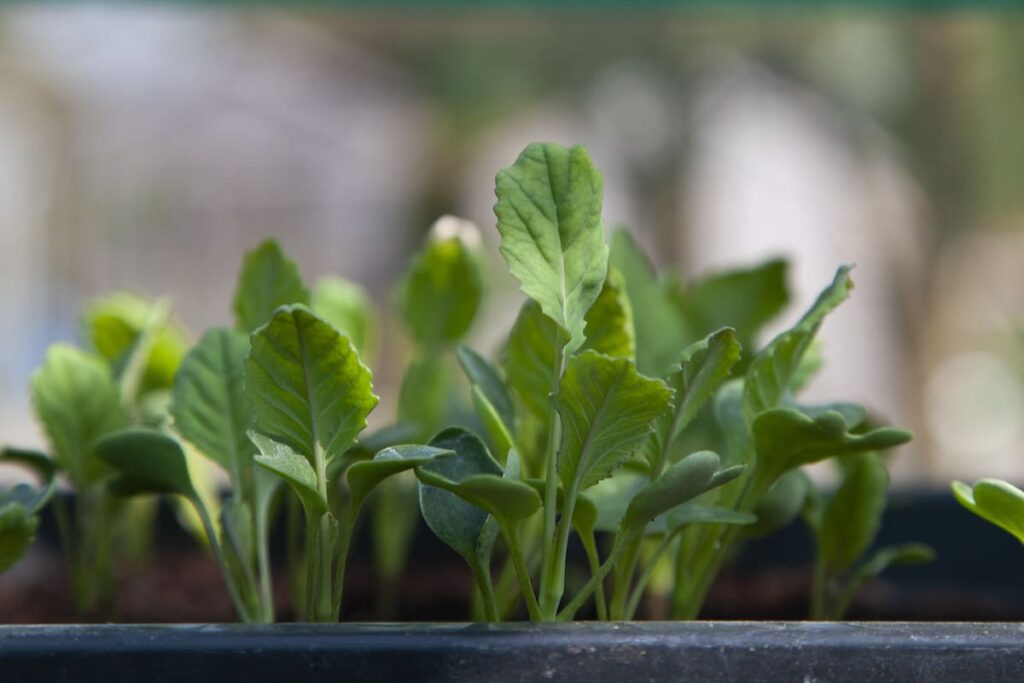
Cauliflower fertilizer requirements
Cauliflower is a heavy feeder and requires plenty of nitrogen, phosphorus, and potassium for optimum growth. A fertilizer with an NPK ratio of 10-10-10 or 12-12-12 is ideal. Apply fertilizer to the soil before planting, at planting time, and then again every 4-6 weeks throughout the growing season. Avoid using high-nitrogen fertilizers on Cauliflower, as they can promote leafy growth at the expense of head development. Excess nitrogen can also cause Cauliflower heads to split open prematurely.
Water requirement for growing Cauliflower
When it comes to watering, Cauliflower does best in moist conditions. Water regularly and deeply, especially during hot weather or extended drought. The growing soil is too wet or too dry can cause the heads of Cauliflower to develop improperly or not form. Cauliflower requires a lot of water to grow properly. The soil should be moistened thoroughly before planting and kept moist throughout the growing season. If the soil dries out, the Cauliflower heads will not develop properly. Water early in the day so the leaves have time to dry before evening, to prevent fungal diseases.
Cauliflower growing problems
Cauliflower is a cool-season crop that can be challenging to grow. The most common problems with Cauliflower are bolting, browning, and blanching. Bolting is when the plant prematurely produces flowers and goes to seed. This can be caused by stress from high temperatures, lack of water, or nutrient deficiency. Browning is when the edges of the leaves turn brown and dry out.
This can be mainly caused by too much sun exposure, wind damage, or insect damage. Blanching is when the center of the head turns brown and mushy. This can be caused by improper spacing, lack of nutrients, or over-watering. It is essential to start with healthy plants, provide adequate water and nutrients, and protect them from stressors such as heat, wind, and insects to prevent these problems.
In case you missed it: Cauliflower Farming (Ghobi) Information Guide
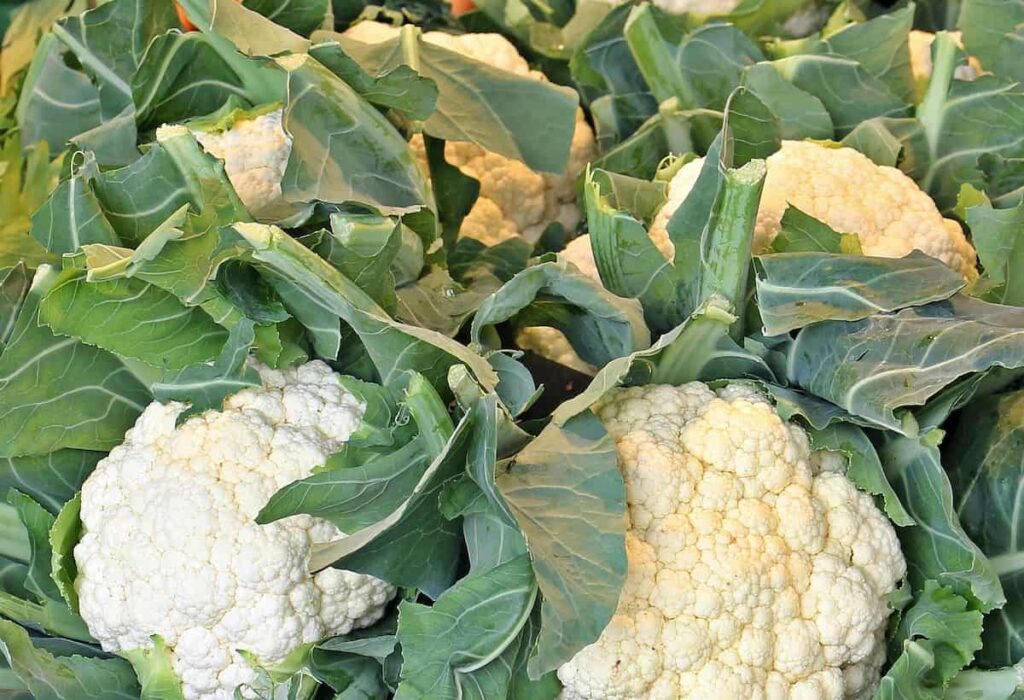
Cauliflower pests, diseases and their control in the USA
- Pests and diseases are the main problems when growing Cauliflower. Many of these problems can be controlled with diligent scouting and prompt treatment. Some common pests include aphids, flea beetles, cabbage loopers, cutworms, slugs, and snails.
- Cauliflower is easy to grow, but some pests and diseases can cause problems. The most common pests are aphids, caterpillars, mites, and whiteflies. These pests can be controlled by using insecticidal soap or neem oil. Diseases that can affect Cauliflower include black rot, downy mildew, and white rust. These diseases can be controlled with fungicides.
Cauliflower growing tips in the USA
- Cauliflower thrives in cooler climates, so if you live in a warmer region, you’ll need to ensure that your plant doesn’t get too much heat. One method is to plant your Cauliflower in an area that gets some afternoon shade.
- You’ll also need to ensure that your soil is rich and loose. Cauliflower roots don’t like being cramped, so amended soil that is easy to spread through will result in a healthier plant when it comes time to fertilize; use a balanced fertilizer low in nitrogen. Too much nitrogen will encourage leaf growth at the expense of the head.
- Once your plant is established, it’s essential to keep an eye on its water needs. Cauliflower heads are mostly made up of water, so they require consistent moisture to stay healthy. That said, you also don’t want to over-water, as this can lead to problems with rot or pests. The main rule is to water the Cauliflower plant if the top inch of growing soil is dry.
- Finally, when it comes time for Cauliflower harvesting, be sure not to wait too long. Overly mature heads will be tough and bitter-tasting. Harvest Cauliflower when the heads are still compact and white for the best flavor and texture.
Cauliflower harvesting tips
Harvesting Cauliflower can be tricky because the heads need to be picked at the right time. The heads will be small and loose if they are harvested too early. If they are harvested too late, the heads will be tough and yellowing. To harvest Cauliflower, cut the stem about two inches below the head using a sharp knife. When it comes to Cauliflower, timing is everything. This cool-weather crop must be harvested at just the right time to be tender and delicious. Below are some tips to help you get it right:
- Check the head size. Cauliflower heads should be about 6-8 inches in diameter when they are ready to harvest.
- Look for compacted heads. The heads should be nice and tight, without any loose florets.
- Inspect the color. The heads should be a nice, uniform white color.
- Use a sharp knife to cut the head from the plant, careful not to damage the surrounding leaves. Cut as close to the stem as possible, so you don’t leave too much of the stalk attached to the head.
- Check the heads regularly and harvest them as soon as they’re ready.
- Store the Cauliflower in a cool, dark place after harvesting.
In case you missed it: Top 16 Steps to Boost Cauliflower Yield: How to Increase Production, Size, and Quality
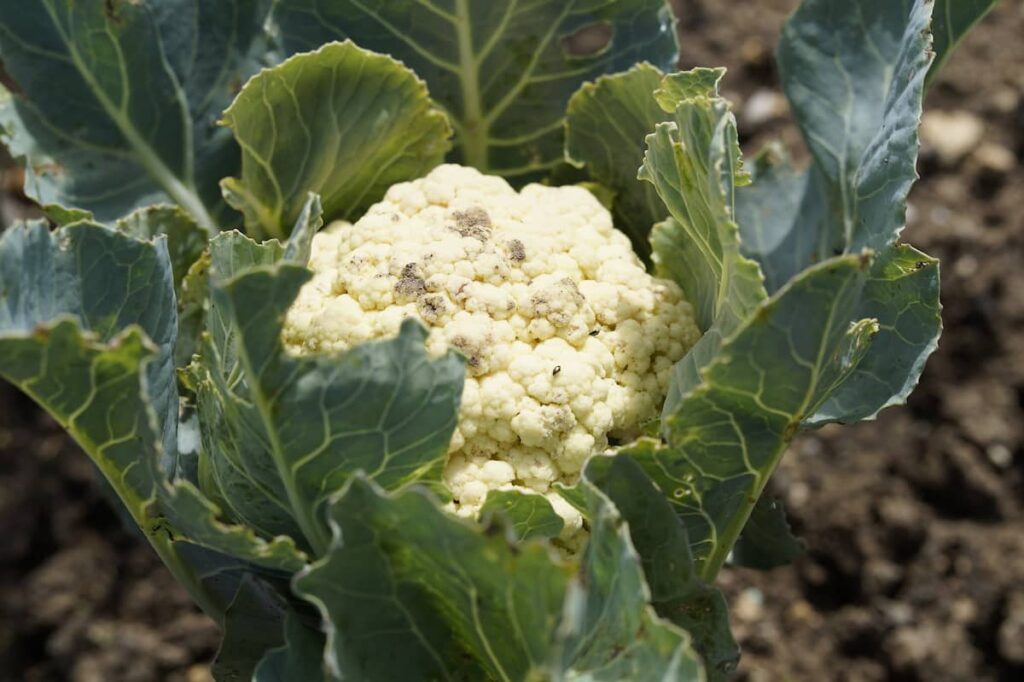
Cauliflower yield in the USA
- Cauliflower yield in the USA is determined by several factors like the variety of Cauliflower, climate, soil type, and farming practices. Overall, Cauliflower yield in the USA is good.
- The average yield of Cauliflower in the United States is about 60 pounds per square foot. This yield can vary somewhat depending on the particular variety of Cauliflower grown and on local climatic conditions and soil type. In general, though, American farmers have been able to produce good yields of this crop.
- One of the keys to successful Cauliflower production in the USA is to start with a high-quality seed. Many varieties of Cauliflower are available, so it is essential to choose a variety that will do well in your particular climate and soil type. Once you have chosen a suitable variety, purchasing high-quality seeds from a reputable supplier is essential.
- Another important factor in determining Cauliflower yield in the USA is proper care and management of the crop. Cauliflower requires consistent moisture and should be watered regularly during the growing season. The crop should also be fertilized according to recommendations for your particular soil type. Finally, proper pest control measures should be taken to keep pests from damaging crops.
Cauliflower marketing in the USA
California is the major Cauliflower-producing state in the USA, with about 90 percent of the supply. Arizona is second, followed by Oregon. To market Cauliflower in the United States, consider exhibiting at local agricultural fairs or participating in farmer’s markets. You could also sell directly to restaurants or grocery stores.
Conclusion
Cauliflower is a cool-season crop that can be harvested year-round in many parts of the world. Cauliflower can be grown in most parts of the United States; however, it is more challenging to grow in hot weather climates.
- Goat Farming Training Programs in India: A Beginner’s Guide
- Types of Pesticides Used in Agriculture: A Beginner’s Guide
- Economical Aquaculture: A Guide to Low-Budget Fish Farming
- 15 Common Planting Errors That Can Doom Your Fruit Trees
- How to Make Houseplants Bushy: Effective Tips and Ideas
- Innovative Strategies for Boosting Coconut Pollination and Yield
- Pollination Strategies for Maximum Pumpkin Yield
- The Complete Guide to Chicken Fattening: Strategies for Maximum Growth
- Natural Solutions for Tulip Problems: 100% Effective Remedies for Leaf and Bulb-Related Issues
- Revolutionizing Citrus Preservation: Towards a Healthier, Greener Future
- Natural Solutions for Peony Leaf and Flower Problems: 100% Effective Remedies
- Maximizing Profits with Avocado Contract Farming in India: A Comprehensive Guide
- Natural Solutions for Hydrangea Problems: 100% Effective Remedies for Leaf and Flowers
- The Ultimate Guide to Choosing the Perfect Foliage Friend: Bringing Life Indoors
- From Sunlight to Sustainability: 15 Ways to Use Solar Technology in Agriculture
- The Ultimate Guide to Dong Tao Chicken: Exploring from History to Raising
- The Eco-Friendly Makeover: How to Convert Your Unused Swimming Pool into a Fish Pond
- Mastering the Art of Delaware Chicken Farming: Essentials for Healthy Backyard Flocks
- 20 Best Homemade Fertilizers for Money Plant: DIY Recipes and Application Methods
- How to Craft a Comprehensive Free-Range Chicken Farming Business Plan
- Brighten Your Flock: Raising Easter Egger Chickens for Beauty and Bounty
- How to Optimize Your Poultry Egg Farm Business Plan with These Strategies
- Subsidy for Spirulina Cultivation: How Indian Government Schemes Encouraging Spirulina Farmers
- Ultimate Guide to Raising Dominique Chickens: Breeding, Feeding, Egg-Production, and Care
- Mastering the Art of Raising Jersey Giant Chickens: Care, Feeding, and More
- Ultimate Guide to Raising Legbar Chickens: Breeding, Farming Practices, Diet, Egg-Production
- How to Raise Welsummer Chickens: A Comprehensive Guide for Beginners
- How to Protect Indoor Plants in Winter: A Comprehensive Guide
- Ultimate Guide to Grow Bag Gardening: Tips, Tricks, and Planting Ideas for Urban Gardeners
- Guide to Lotus Cultivation: How to Propagate, Plant, Grow, Care, Cost, and Profit
- Agriculture Drone Subsidy Scheme: Government Kisan Subsidy, License, and How to Apply Online
- Ultimate Guide to Raising Araucana Chickens: Breed Profile, Farming Economics, Diet, and Care
- Bringing Hydroponics to Classroom: Importance, Benefits of Learning for School Students
- Ultimate Guide to Raising Polish Chickens: Breed Profile, Farming Economics, Diet, and Care
- Ultimate Guide to Raising Australorp Chickens: Profile, Farming Economics, Egg Production, Diet, and Care
- Silkie Chicken Farming: Raising Practices, Varieties, Egg Production, Diet, and Care